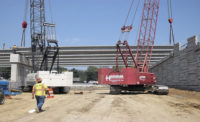If regional opportunities don't match those of "bounce back" states, including Florida, Nevada and Georgia, nor is the potential as great for razor-slim margins, which are pushing contractors to the precipice in other regions. "Firms are anxious to return to work, even where margins are very, very low," says Basu. "Factor in costs of hiring back staff and renting equipment, and we're beginning to see firms fail in those bounce-back states. Even in Illinois and Wisconsin, bids on school projects have come in below budget."
Midwest builders face additional headwinds, many of them more indigenous to the region than the cycle of economic conditions. Slow population growth continues to put a drag on new housing starts and, by extension, retail, office and hotel construction. High tax rates continue to deter enterprises from locating in the region.
"Midwest states also carry extremely heavy pension burdens and large numbers of union members," says Simonson. "And states are all having trouble with their budgets." Large metro areas, including St. Louis and Milwaukee, likewise are struggling to reconcile revenue and spending, particularly in comparison with cities on the nation's West Coast.
"Detroit is the most extreme example of that trend," says Simonson.
Among other tactics, Chicago is proposing to close its gap with a $0.75 hike in cigarette taxes, in addition to earning greater income from speeding tickets, now that the city has installed video cameras to monitor vehicular traffic.
Chicago also is spending aggressively on public projects to increase tourism or enhance its prospects as a business center. In addition to improvements to Navy Pier, the city is proceeding with plans to revitalize McCormick Place, its largest convention center, by surrounding it with an entertainment district, including a new multi-use arena.
To ease access to Chicago, the city is set to proceed with construction of a new $800-million intermodal transit facility at O'Hare International Airport, having received a $292-million federal loan for the project under a provision of the 1998 Transportation Infrastructure Finance Innovation Act. City officials estimate the project will create 3,000 construction jobs.
Prospects for the city appear somewhat brighter than the surrounding state, "where conditions just grow worse and worse," says Simonson. Nevertheless, Illinois is spending heavily on public construction, the majority involving roads and bridges funded by non-traditional sources, including income from video gambling as well as hikes in liquor taxes.
Earlier this year, the Illinois Dept. of Transportation began preliminary work on a $475-million makeover of Chicago's Circle Interchange, known as the nation's worst bottleneck for trucks and one of the worst for automobiles. IDOT estimates the project will create 5,000 construction jobs before work is completed.

